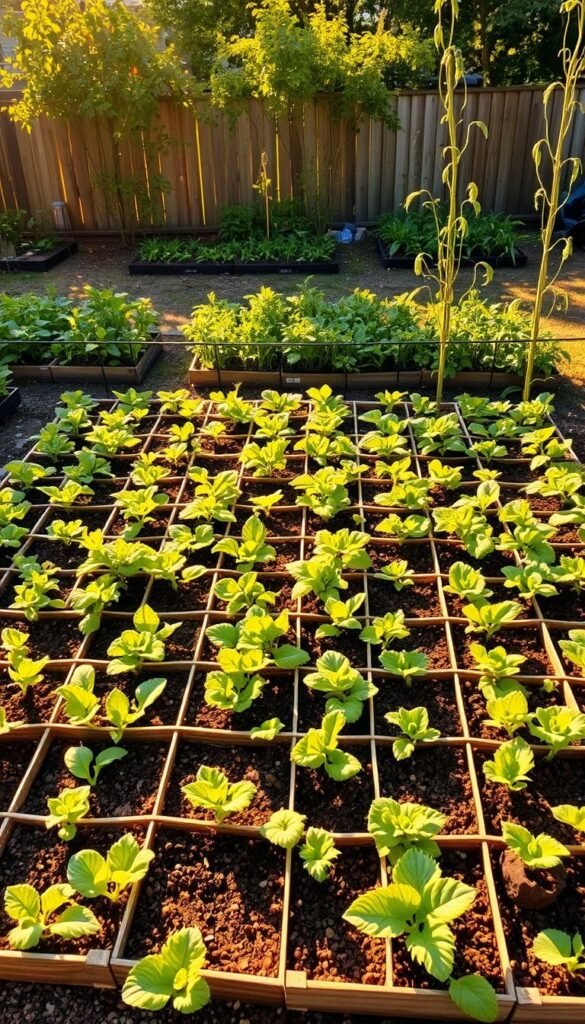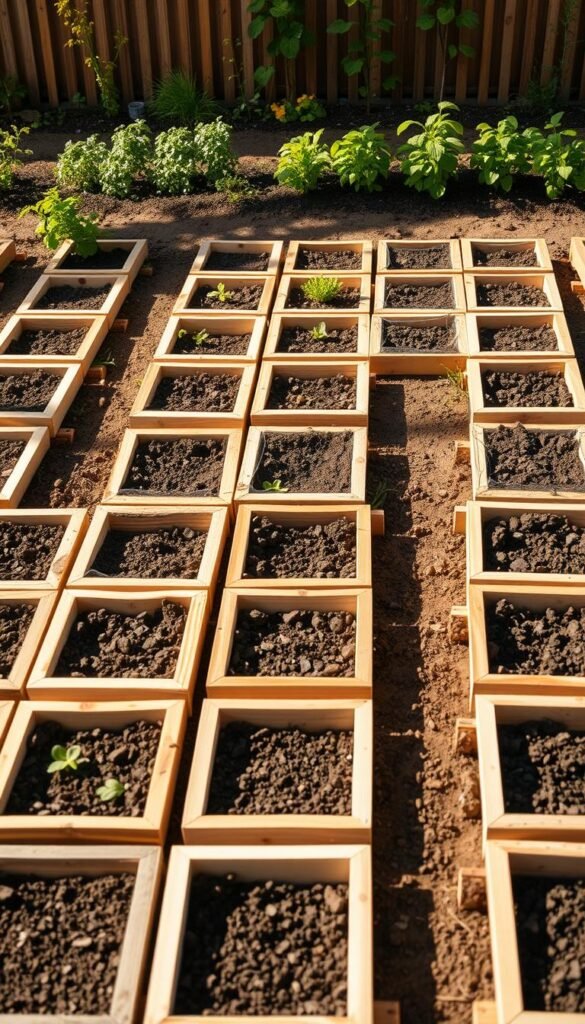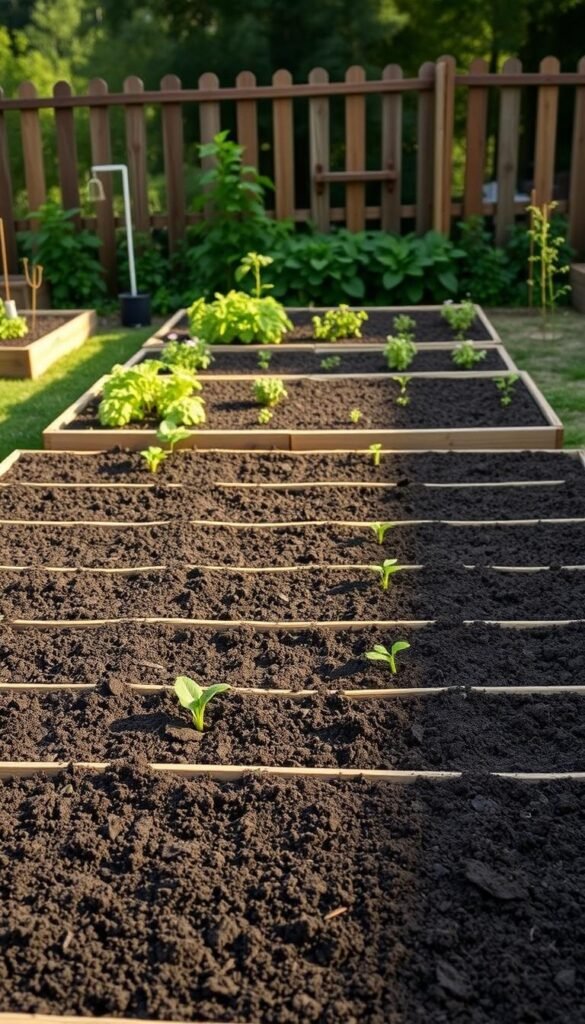Imagine growing fresh veggies in a space smaller than your patio furniture. Square foot gardening makes this possible by turning tiny plots into thriving green zones. This method uses a grid system to organize crops, letting you grow more food with less effort. Perfect for balconies, backyards, or even rooftops, it’s ideal if you’re short on time or ground.
The secret lies in raised beds filled with a special soil blend. Experts recommend a mix of compost, peat moss, and vermiculite for maximum growth. Unlike traditional gardens, this setup prevents weeds and reduces watering. You’ll spend minutes, not hours, maintaining your plants.
Popularized by Mel Bartholomew, this approach cuts costs and labor by half compared to regular gardening. Whether you want crisp lettuce or juicy tomatoes, this simplified raised bed system adapts to your needs. Even beginners can harvest baskets of produce in weeks.
Ready to ditch grocery-store veggies? With just a few supplies and sunlight, you’ll enjoy homegrown meals while reducing food waste. Let’s dig into the steps to create your own lush, bite-sized paradise.
Key Takeaways
- Grow more food in less space using organized grids.
- Raised beds with nutrient-rich soil boost plant health.
- Save time with minimal weeding and watering.
- Cut costs by up to 50% compared to traditional gardens.
- Perfect for balconies, patios, or small yards.
- Harvest fresh produce in as little as 4-6 weeks.
Introduction: Embracing the Square Foot Gardening Method
What if your dream garden fit in a corner of your patio? This foot gardening method turns compact spaces into productive green zones. Instead of endless rows, you’ll work with organized squares that simplify every step—from planting to harvest.

Why Choose Square Foot Gardening?
Traditional gardens demand hours of weeding and watering. Here, a 4×4-foot grid system does the heavy lifting. You’ll grow up to 16 crops in one bed while using 80% less soil. Mel Bartholomew, the method’s creator, notes it requires “2% of the work” compared to conventional plots.
Raised beds filled with a fluffy soil mix (compost, peat moss, and vermiculite) prevent weeds naturally. No backbreaking digging—just drop seeds into neat squares. You’ll water precisely where roots need it, saving time and resources.
The Benefits for Beginners
New to gardening? This approach removes guesswork. Each square holds one type of plant, so you’ll never overcrowd seedlings. Start small with herbs or lettuce, then expand as confidence grows.
Costs stay low since materials like wood planks and twine build beds quickly. Square foot gardening also adapts to containers if ground space is limited. In weeks, you’ll snip fresh basil or pull radishes—no farming experience required.
Best part? You control the pace. Tend your garden for minutes daily, not hours. It’s gardening simplified: smart, sustainable, and satisfying.
Essential Tools, Materials, and Soil Preparation
Your garden’s success begins long before seeds hit the ground. The right foundation transforms cramped spaces into lush producers. Let’s explore what you’ll need to build a thriving micro-farm.

Selecting the Right Soil Mix and Compost
Forget ordinary dirt. Your plants crave a custom blend that feeds roots and drains well. Experts swear by equal parts compost, peat moss, and vermiculite. This trio creates fluffy beds where vegetables explode with growth.
Use five types of compost if possible—leaf mold, mushroom, worm castings, and two plant-based varieties. This diversity provides balanced nutrients. Avoid dense garden soil that suffocates roots. “Your mix should feel like chocolate cake crumbs,” says urban farming consultant Lisa Taylor.
Gathering Your Tools and Building Supplies
Start with untreated cedar planks for raised beds—they resist rot naturally. You’ll need:
- 4 boards (6″ tall x 4′ long)
- Galvanized screws
- Landscape fabric
- Grid-making materials (wood strips or nylon string)
A sturdy shovel mixes soil components efficiently. Grab gloves and a hand trowel for planting. Skip flimsy tools—they break when compacting heavy mixes. For small spaces, consider fabric planters instead of wooden beds.
Remember: quality materials prevent mid-season disasters. Warped boards collapse, while poor compost stunts growth. Invest wisely now for seasons of harvests.
Getting Started with Square Foot Gardening: A Beginner’s Guide
Your garden’s potential blooms when each plant finds its perfect spot in the sun. Start by sketching a 4×4 grid on paper—sixteen squares become your edible canvas. Mark areas receiving 6+ hours of daily sunlight for tomatoes and peppers. Reserve shadier corners for leafy greens like spinach.

Smart Grid Design Strategies
Use nylon string or thin wood strips to divide beds into clear sections. “Treat each square like its own mini-garden,” suggests urban farmer Emma Biggs. Tall crops go northward to avoid shading neighbors. Pair deep-rooted carrots with shallow lettuce to maximize space.
Rotate crops seasonally: follow nitrogen-hungry kale with soil-restoring beans. Mix edible flowers like nasturtiums among vegetables—they repel pests while adding color. This gardening foundation prevents disease and keeps soil nutrient-rich.
Cultivating Purposeful Goals
Grow what you’ll actually eat. Love salsa? Dedicate six squares to tomatoes, onions, and cilantro. In dry climates, choose drought-resistant herbs over thirsty cucumbers. Track success in a journal: note which varieties thrive in your square foot garden.
Balance beauty and bounty by tucking marigolds between cabbage plants. Their bright blooms deter pests while creating visual interest. With thoughtful planning, your foot gardening foundation becomes both pantry and paradise.
Step-by-Step Guide to Building Your Raised Bed
Building your raised bed is like crafting a treasure chest for plants—except the gold grows on vines. Start with untreated cedar or rot-resistant lumber for longevity. Cut four 4-foot boards to create a box that’s 6-12 inches deep—this depth supports most vegetable roots.

Constructing the Bed Frame with Quality Materials
Assemble the raised beds using galvanized screws at each corner. Reinforce the sides with corner blocks for extra stability. Place the frame on level ground, leaving 18-inch walking paths around it. “A wobble-free base prevents soil shift during heavy rains,” notes landscape designer Michael Brown.
Filling Your Raised Bed with the Optimal Soil Mix
Fill your foot garden with equal parts compost, peat moss, and vermiculite. This mix retains moisture while draining excess water. Layer materials like lasagna—start with cardboard to smother weeds, then add your fluffy soil blend.
Top it off by snapping a grid of string across the square foot bed. These visible lines become your planting guide. For extra support, add a low wooden framework around the bed’s rim—it’s perfect for attaching plant labels or shade cloth.
Designing Your Garden Grid and Planting Strategy
Transform your garden into a living chessboard where every move yields delicious rewards. A well-planned grid acts as your blueprint, ensuring each plant thrives without competing for resources. Let’s explore how to turn those 16 squares into a high-performance food factory.
Mastering the Art of Grid Layout
Use weather-resistant materials like nylon string or cedar strips to create visible dividers. Snap lines tightly across your bed to form crisp 1-foot squares. Label each section with chalk or plant markers for easy identification. “Clear grids prevent accidental overcrowding,” notes urban gardener Maria Cortez.
Smart Spacing and Crop Combinations
Follow these spacing guidelines:
- 1 per square: Tomatoes, peppers
- 4 per square: Lettuce, herbs
- 9 per square: Radishes, carrots
- 16 per square: Green onions
Pair deep-rooted crops with shallow greens to maximize space. Try basil beside tomatoes—they repel pests while enhancing flavor. Avoid planting mint or oregano near carrots; their vigorous roots create competition.
Growing Upward for Better Yields
Install trellises on the north side for climbing beans or cucumbers. A simple A-frame made from bamboo poles adds 50% more growing area. Train indeterminate tomatoes upward using soft twine. Vertical structures improve air circulation, reducing mildew risks.
Track your planting choices in a notebook—note which combinations boosted harvests. Next season, rotate crops to different squares to maintain soil health. With this strategic approach, your garden becomes both efficient and endlessly adaptable.
Practical Tips for Daily Maintenance and Care
Your thriving garden starts with simple daily habits. Consistent care keeps vegetables healthy and maximizes yields while saving time. Let’s explore how to balance watering, weed control, and observation for a productive plot.

Effective Watering and Mulching Strategies
Water plants early using a long-spout can to target roots. Check soil moisture by sticking a finger 1 inch deep—if dry, hydrate gently. In hot weather, add shade cloth to reduce evaporation.
Spread 2 inches of straw or shredded leaves as mulch. This locks in moisture and blocks 90% of weeds. Avoid wood chips—they can rob soil of nitrogen as they decompose.
| Task | Frequency | Time Needed |
|---|---|---|
| Deep watering | Every 2-3 days | 10 minutes |
| Mulch refresh | Monthly | 5 minutes |
| Soil check | Weekly | 2 minutes |
Weeding, Pruning, and Record-Keeping for Future Success
Pluck weeds when they’re small—daily checks prevent root invasions. Use scissors to trim yellow leaves every Thursday. This keeps plants focused on growing edible parts.
Track progress in a notebook: note which seeds sprouted fastest or struggled. Next season, rotate crops based on these records. Windy areas? Mark which stakes held up best.
New gardeners often ask: “How much is too much?” A 5-minute daily walkthrough catches issues early. Pair this routine with seasonal adjustments for a gardening foundation that improves yearly.
Conclusion
Your journey to fresh, homegrown meals begins with just sixteen squares. By organizing crops in grids and using nutrient-rich raised beds, you’ll harvest up to five times more food than traditional gardens. Studies show this method uses 80% less water and slashes weeding time by 90%—perfect for busy lifestyles.
Start strong with Mel’s soil mix (compost, peat moss, vermiculite) and strategic planting. Remember: tomatoes thrive with 12-18 inches of vertical space—train them on trellises to boost airflow. As you gain confidence, experiment with stacking planters or intercropping radishes between slower-growing crops.
Keep notes on which varieties perform best in your square foot garden. Did rainbow chard outproduce kale? Adjust next season’s plan accordingly. For ongoing success, discover more tips on crop rotation and pest management.
Ready to taste the difference? Grab some seeds, sketch your grid, and watch tiny spaces transform into edible jungles. Your future self will thank you—one crisp cucumber at a time.






